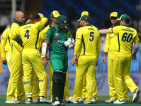Four years in the making
Glen Chudley |
When Jos Buttler ran out Martin Guptill to tie the 2019 World Cup Final Super Over which saw England emerge as men’s ODI champions for the first time, it wasn’t just a tense finish to a firecracking rollercoaster of a match or even just the end of an intense and closely fought tournament. It was the deserved closure of four years’ worth of preparation and reinvention in search of the ultimate payoff.
England’s progression from a wretched early exit at the 2015 World Cup to worthy finalists at the 2019 edition is well documented. After crashing out of the 2015 tournament at the hands of Bangladesh with their approach and skillset proving vastly unsuited to the modern game, England reinvented themselves as an ODI team. A new coach was brought in and with him a new approach: attack, attack, attack. The results were immediate and impressive. In their first ODI with head man Trevor Bayliss at the helm, England smashed their first ever 400-plus score in the format against New Zealand in a series which also saw them complete their (at the time) highest successful run-chase. A new era had not only dawned, but had well and truly been ushered in.
The next few years saw this revitalised approach bring England unprecedented levels of success in the format, not only in terms of results, but also in terms of the many records broken. There was the highest 10-wicket run chase in history (since surpassed by South Africa), achieving a world-record score against Pakistan and doing so again against Australia in 2018 as part of their first ever 5-0 series whitewash. These are just a sample of the at times stunning feats the team accomplished as they refined their blitzkrieg method and rose to the top of the ODI rankings in the leadup to the 2019 World Cup.
It was not smooth sailing all the way. The mountainous highs were punctuated by the occasional abysmal low, mostly when the flaws in England’s approach with the bat (one-dimensional for all its success) were exposed, but also when their bowling – by now their weaker suit by far – was shown to be less adept at defending a total than their batsmen were at setting one. It was these chinks in the side’s armour which led to many people question whether, for all the improvement on show, England’s new paradigm of ODI cricket might just let them down when it mattered the most.
Indeed, it had already proved to be the team’s downfall on the more modest, but still important stage of the 2017 Champions’ Trophy. Having breezed through the group stages of that tournament, England faltered in their semi-final against Pakistan. Having grown fat on a diet of flat, batting-friendly pitches, England stumbled on a trickier – but by no means unplayable – surface. They were bowled out for a disappointing 211 before their bowlers put in an underwhelming performance of their own, taking only 2 Pakistani wickets as the eventual tournament victors eased their way into the final.
England returned to their (mostly) winning ways after the conclusion of the Champions’ Trophy but their renewed successes were interspersed with a few abject failures which indicated their struggles in tougher conditions were not a thing of the past. Most notably against Australia on their 2017/18 tour there, they sunk to 8-5 before managing to stage something of a recovery. As late as early 2019, a dismal capitulation against the West Indies only intensified fans’ concerns that an inability to adapt their game would prove to be England’s undoing in the now fast-approaching World Cup. While their series of high scores in their final pre-tournament series against Pakistan were impressive they didn’t tell anyone anything they didn’t already know.
Ahead of the World Cup, England had sought to go some distance to covering their other weakness – their bowling – by calling up Barbadian-born fast bowler Jofra Archer, who became eligible to represent England after a change to their residency period rules to bring them directly in line with ICC regulations. A decent showing against Pakistan secured his spot in the World Cup squad and provided a welcome boost the England’s bowling lineup. The side then had to deal with the critics of their now-established approach to ODI batting, both in terms of conditions and whether it would stand up to the additional pressure of World Cup Cricket.
The question of conditions was thrown into sharper focus when it soon became apparent that the pitches in use during the tournament would not be the batting paradises many had expected (and indeed feared), but would invariably offer at least something for the bowlers to work with. It too became apparent that – due to pitches or pressure – chasing totals in this World Cup was significantly harder than had generally been observed in the many bilateral series played over the last few years. This was another potential stumbling-block for England as they had found most of their recent success whilst chasing.
In fact, their first loss of the tournament would turn out to be a failed chase against Pakistan. Set 349 to win, England never looked as assured as they had whilst chasing similar totals against the same team just weeks earlier. A pair of superb innings from Joe Root and Jos Buttler took their response to an impressive level of respectability, but the match left observers who had suggested that England would be unable to replicate their feats of recent times in a genuine pressure environment feeling vindicated.
England won their next few matches comfortably, with a clinical bowling performance against the West Indies giving hope that that particular weakness had been somewhat mitigated. However their other problems reared their heads when, having restricted Sri Lanka to what appeared to be an eminently gettable 232, they proceeded to falter in their chase. This was due to excellent bowling from Lasith Malinga, but more pertinently due to an enduring hole in their batting game when playing on slower pitches.
Having now lost two matches they had been widely expected to win, England were now faced with the tough task of needing to win two of their next three matches to guarantee a semi-final spot. Their opponents – Australia, India, New Zealand – were likely semi-finalists so England with pressure mounting would have to perform against their toughest opponents of the tournament.
When they fell comfortably short of chasing a target of 286 against Australia, justifiable questions over whether, for all their evident improvement, England indeed had what it took to emerge victorious on the biggest stage resurfaced in abundance.. There was an increasing feeling that their limitations had been exposed or that they had simply bottled it. Whilst a team-best World Cup total against Bangladesh and a record-breaking innings from Eoin Morgan against Afghanistan had at least proved that England’s best qualities could translate to a major tournament, they served only to reinforce the impression of a team that had focussed on its eye-catching strengths to the detriment of potentially fatal weaknesses. Whatever the reason for their situation, England’s last two games of the round-robin stage of the tournament were effectively knockout affairs and they were under severe pressure to perform
Memorable cricketing performances, whether by a team or an individual, rarely come without a slice of fortune. This England team’s lucky break came with the chance to bat first on a surface which proved to be far more conducive to run-scoring than those on which they had just lost two consecutive matches. A much-improved score of 337, kickstarted by a maiden World Cup century from Jonny Bairstow and a pair of excellent opening spells from Chris Woakes and Jofra Archer set them up for a convincing win. The confidence gained from this turnaround evidently carried into England’s final match of the round robin stage where Bairstow’s second century in as many games took his team to 305/8. They followed up by bowling New Zealand out for 186 which whilst admittedly assisted by a pair of run-outs – one avoidable and one extremely unlucky – demonstrated that this now-resurgent England team did indeed have all the tools at their disposal to lift the coveted trophy.
England don’t lose at Edgbaston. Australia don’t lose in knockout matches. These two facts clashed head-to-head as the two sides in question met in the second semi-final, with the first having seen New Zealand eliminate India in a thriller. When Australian captain Aaron Finch won the toss and elected to bat, it appeared that England’s newly-found frailty whilst chasing would be put to the test but a match-defining opening spell saw Australia reduced to 14-3. A century stand between the ever-dependable Steve Smith and Alex Carey, arguably Australia’s find of the tournament, threatened to defy England until the host nation’s previous weak bowling link in the tournament to date, Adil Rashid, struck to put Australia on the back foot, with only some lower-order resistance from Mitchell Starc allowing them to scrape to 223.
Even at this stage, the natural pessimist that lives within most fans of English sport was not daring to hope that this chase was as simple as it looked on paper. They needn’t have worried. For the first time since their very similar chase against the West Indies earlier in the tournament, England looked totally at ease as they batted their way effortlessly to the total and with it, for the first time in 27 years, the World Cup final.
By getting this far England had answered most of the questions regarding their abilities and resilience – and silenced most of their doubters – and relegated their ignominious performance at the previous World Cup to a distant memory. But, for all this, there was general feeling that unless this tournament ended with England lifting the trophy, it would all have been in vain – particularly as the vast improvement enjoyed by the One-Day team was considered by many to have come at the expense of consistency in the Test arena. Moreover, with coach Trevor Bayliss’ post-summer departure having been announced some time in advance, it was clear that all levels of English cricket saw this tournament as their one chance. It was now or never and no-one, least of all the England team, would settle for second best.
What transpired on July 14th need not be recounted here as it is already imprinted – probably forever – into the memories of all who saw its dramatic twists and turns unfold into what many believe the greatest ever One-Day International. A close contest throughout became a wild rollercoaster as it twisted and turned again and again towards its conclusion. It was not without its share of controversy as England overcame their weakness in chasing on a tricky though not impossible pitch which led to a tie, before the finale of a tense Super Over saw them emerge victorious on boundary countback to claim their inaugural World Cup trophy. That a freak stroke of luck (and, it would transpire, an incorrect application of the rules) had saved England from falling agonisingly short and the contrived methodology by which they were awarded the trophy didn’t matter to them. The past four years of tumultuous years of highs, lows, rebirth and banishing the demons of their past had not been in vain. Victory was theirs.




Great article Mr Chudley!
Comment by Marc | 1:01pm BST 19 July 2019
Very fair and factual article – and I loved the comment about our natural pessimism. No matter the game, England are past masters at screwing up at the last moment.
Comment by Joe Clarke | 4:00pm BST 19 July 2019
Thank you both for your kind comments!
Comment by Glen Chudley | 7:16pm BST 20 July 2019